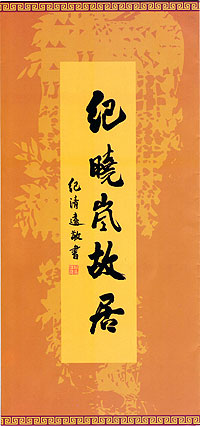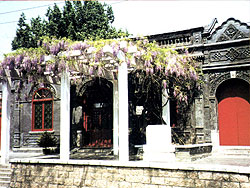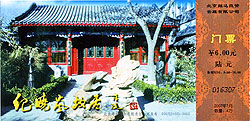|
|||||||||
|
ARTICLESA Non-Princely Mansion from Qing-dynasty Beijing Tourist leaflet of the Residence of Ji Xiaolan.
Tourist leaflet of the Residence of Ji Xiaolan.
Ritual regulations governed every aspect of life in the Qing dynasty (1644-1911), and all dimensions and fittings of houses were prescribed in accordance with a gradated code at the pinnacle of which was the palace complex of the emperor. Strict regulations further governed the attributes and decoration of houses, carriages and clothing of the nobility and of the officials who served the government. In their architectural dimensions, princely mansions could neither encroach upon nor appropriate features of the emperor's residential quarters. Moreover, the residences of officials could not exceed the residences of princes in their dimensions. Nevertheless, there was a basic architectural similarity among these residences. (Fig.1)  Fig.1 External view of the study from the garden at the Residence of Ji Xiaolan. [Photo: BGD] Fig.1 External view of the study from the garden at the Residence of Ji Xiaolan. [Photo: BGD]
Apart from palaces and princely mansions, surprisingly few Qing-era residences of officials and commoners remain intact in Beijing. Even buildings deemed to originate in the Qing dynasty are usually composite structures with additions dating from various periods of the twentieth century. The residences of officials that date from the eighteenth and nineteenth centuries tend to be constructed in a style similar to the modular model that informed the residences of emperors and nobles, but there are some exceptions. The Career of Ji YunOne residence that is quite unlike any of Beijing's palaces or princely mansions is the former home of the official, scholar and literary figure Ji Yun ( 紀昀 1724-1805), best known for its Jesuit Rococo entrance, of which very few examples can be seen today in Beijing (see, however, 'Prince Gong's Folly' in this issue). (Fig.2)  Fig.2 Unorthodox view of the exterior at the front of the Ji Xiaolan's residence. Fig.2 Unorthodox view of the exterior at the front of the Ji Xiaolan's residence.
Ji published five collections of supernatural tales between 1789 and 1798, and in 1800 the five volumes were produced under the collective title Yuewei caotang biji (Jottings from the grass hut for examining minutiae), an obscure title for an otherwise earthy and enjoyable collection of imaginative fiction. But he is better known for what was the magnum opus of Qing editorial achievement, Siku quanshu (The Complete Library in Four Branches). From 1773 onwards, Ji Yun edited this massive work together with Lu Xixiong, in compliance with an imperial edict issued by the Qianlong Emperor.  Fig.3 An entrance ticket to the Residence of Ji Xiaolan. Ji Yun rose to intellectual prominence after winning the highest distinction in the provincial examinations in 1747. In 1754, he attained the jinshi degree, whereupon he entered the Hanlin Academy. His career was not, however, smooth sailing. In 1768, he became an accessory in a bribery case after he tipped off a brother-in-law about the severity of charges pending against him, for which crime he was banished to Urumqi in Chinese Turkestan. He was pardoned after a year, and, on his return journey in 1771, he wrote a travel account distilled into 160 poems titled Xinjiang zalu (Assorted verses on Xinjiang). This remains one of the most useful sources in Chinese on life in Chinese Turkestan in the late-eighteenth century. On arriving back in China, Ji was received by the Qianlong Emperor in 1771 when the ruler happened to be returning from Jehol to Beijing, and he was ordered to write a poem on the return of the Turgut Mongols from the banks of the Volga. Ji's rendition of the inspiring tale of the return of the exiled Mongols, later celebrated in English by another poet Thomas de Quincey (1785-1859) in his epic Revolt of the Tartars, delighted the emperor, for whom he became an unofficial poet laureate. The job of compiling Siku quanshu was his dubious reward.  Fig.4 The Jesuit Rococo entrance. [Photo: BGD] Fig.4 The Jesuit Rococo entrance. [Photo: BGD]
At the same time as the emperor commissioned Siku quanshu, he ordered a more intimate compilation to be a companion in the imperial study. Ji Yun thus also edited an abridged version of the encyclopaedic work—Siku quanshu huiyao—that could be housed in a study in the palace. One set was held in the Forbidden City, the other at the emperor's other main residence, the Garden of Perfect Brightness (Yuanming Yuan, see China Heritage Quarterly, issue 8, December 2006). The Mansion of Ji XiaolanToday Ji's Beijing residence is open to visitors, and one can see the study in which Ji Xiaolan supposedly wrote Yuewei caotang biji and the summaries for the compilations Siku quanshu and Siku quanshu huiyao.(Fig.3) The visitor enters through a narrow front gate, the renowned Jesuit Rococo gateway, to one side of the central building and passes into a modest courtyard.(Fig.4) At the southern end of the courtyard is a hall, which is reputedly the original reception room used Ji Yun, now occupied by a shop selling antiquities and souvenirs.(Fig.5)  Fig.5 External view of the 'main hall' on the southern side of the garden. [Photo: BGD] Fig.5 External view of the 'main hall' on the southern side of the garden. [Photo: BGD]
The mansion in which Ji Yun lived for the last thirty years of his life was originally the residence of General Yue Zhongqi (1686-1754), the twenth-first generational descendant of the renowned Song dynasty loyalist and general Yue Fei, who is one of the most renowned figures in Chinese history. General Yue fought alongside General Nian Gengyao in quelling Muslim and Tibetan rebels in what is today Qinghai, and was highly honoured in Beijing. He never lived for very long in the capital, his base being in Sichuan and Gansu. However, he was rewarded for his service to the throne by the Kangxi Emperor and raised to the position of duke of the third class.  Fig.6 Sculpture of Ji Yun. [Photo: BGD] Fig.6 Sculpture of Ji Yun. [Photo: BGD]
Ji Yun lived in the mansion for thirty years and several features of the dwelling that the visitor can still see today are associated with him. A tree in the garden is said to be more than two hundred years old. Few original items from the time of Ji Yun remain in the house but the caretaker claims that the desk and mirror in the main study are original items.(Figs.7&8) The glass mirror in the zitan timber frame is one of the earliest mirrors produced with lead paint in China. After Ji Xiaolan's death, his descendants rented half of the mansion complex out to Huang Antao (1777-1847), a jinshi scholar, Hanlin scholar and poet, like Ji Yun. Huang was a renowned calligrapher; several of his calligraphic pieces are in the collection of the Palace Museum. Surviving into the Twentieth CenturyThe mansion, located at what is today 241 Zhushikou West Street in the Xuanwu District of the former Outer City of Beijing was not originally tiny. Yet even though very little of the original mansion survives, its rear section is now virtually tenement housing, accommodating more than one hundred families! This warren of courtyards lies on the southern side of Liulichang. The tiny garden and study we see today thus represent only one small corner of what was once a vast residence the area of which rivalled that of many of Beijing's former princely mansions.  Fig.7 View of the original zitan timber desk in the study in the Residence of Ji Xiaolan. [Photo: BGD] Fig.7 View of the original zitan timber desk in the study in the Residence of Ji Xiaolan. [Photo: BGD]
However, the section of Ji's residence that does remain may have only survived because of its unique place in twentieth-century history. In 1930, a prominent left-wing scholar and supporter of the Communist Party from Shanxi province called Liu Shaobai rented the house. Born in 1883, Liu Shaobai was a xiucai graduate in the last imperial examinations held in 1905. In Communist Party annals, he is accorded the rare distinction of being a member of the gentry (shenshi) who had six audiences with Chairman Mao. Shortly after Liu Shaobai rented the residence, it became a safe house for Communists and the location of a clandestine cell linked with the Communist Party organisations in Hebei and Shanxi provinces. Thus, the house became known to and frequented by Peng Zhen (1902-1992), the founder of the Shanxi Communist Party, and future mayor of Beijing (also, one of the architects of the old city's destruction).  Fig.8 View of the mirror in the study. [Photo: BGD] Fig.8 View of the mirror in the study. [Photo: BGD]
In 1937, the house became a dormitory and training place for Peking Opera students of the Fu Lien Ch'eng Peking Opera troupe of Mei Lanfang, but despite this it seems to have a remained a liaison point for Communists. On the eve of the 1948 Communist take-over of Beiping (subsequently renamed Beijing), it was a branch of an old-style Shanxi bank (yinhao), perhaps involved in channelling funds to the Communists. After the founding of the People's Republic in 1949, the mansion at different times housed the offices of a transport company and the local district party school. In 1959, Peng Zhen, now mayor of Beijing, turned the hotel into a Shanxi restaurant and hostel called Jinyang Fanzhuang. In 1989, a new premises for the hotel was built next door. In 2001, Guang'an Street was widened and members of the public, concerned that the former 'mansion' of Ji Xiaolan might be demolished, called for the restoration of the building. This was carried out and, in November 2002, what remained of the mansion now named the 'Residence of Ji Xiaolan' (Ji Xiaolan guju) was opened to the public. (BGD) |